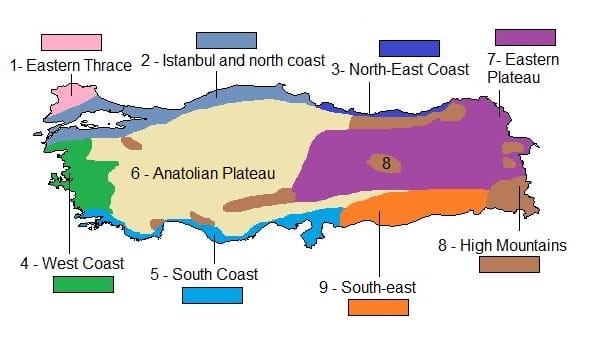Turkey, a bridge between Europe and Asia, emerges as a tapestry woven from diverse climatic threads, each contributing to its distinct environmental narrative. Imagine standing on this geographical crossroads, where the whisper of the Aegean waves mingles with the rustling whispers of wind through the Anatolian plains. The climate in Turkey is as multifaceted as its rich history and culture, offering an array of experiences that reflect the country’s unique geography.
The diverse climatic zones of Turkey can be mainly categorized into four distinct regions: the coastal regions, the interior plateau, the eastern highlands, and the southeastern region. Each of these zones poses distinct characteristics that play a pivotal role in shaping Turkey’s agricultural practices, biodiversity, and even the lifestyles of its populace.
1. Coastal Regions: The Gentle Embrace of the Mediterranean
The breathtaking coastal areas of Turkey, particularly along the Aegean and Mediterranean seas, are known for their temperate Mediterranean climate. Here, summers bask in warm, sun-soaked glory, with temperatures often soaring above 30°C (86°F). The sun-drenched days give way to balmy evenings, providing an ideal atmosphere for leisurely walks along the coast, where vibrant bougainvilleas spill over old stone walls and local tavernas hum with the laughter of families enjoying fresh seafood.
Winters in these coastal regions contrast strikingly; they are mild and relatively wet, with temperatures seldom dipping below 10°C (50°F). The lush vegetation thrives, and the landscape dons a vibrant mantle of green. This climate nurtures olive groves, vineyards, and citrus orchards, showcasing the agricultural richness that has sustained civilizations for millennia.
2. The Interior Plateau: A Dance with Extremes
Life in the interior is resilient. The vast steppe supports an agricultural economy that relies heavily on drought-resistant crops such as barley and wheat. The stark beauty of the landscape, punctuated by the intriguing rock formations of Cappadocia, captures the imagination. Here, the concept of time finds its expression through the gradual erosion that has sculpted this unique territory, akin to the gradual evolution of cultural narratives woven among the ancient ruins scattered throughout the region.
3. Eastern Highlands: Where the Mountains Kiss the Sky
The eastern highlands of Turkey present a more rugged aspect of the climate equation. With mountains rising majestically, this region is characterized by its harsh winters and cool summers. Precipitation is abundant, particularly in the winter months, transforming the landscape into a veritable wonderland of snow and ice. On occasions, pockets of lush alpine meadows burst forth during the brief summer months, creating a striking contrast against the craggy terrain.
Here, the high-altitude climate fosters a unique biodiversity, where endemic species thrive despite the challenging conditions. The culture of the eastern highlands is as rich as the landscape, with vibrant traditions and folklore deeply rooted in the connection between the people and their environment. The inhabitants have adapted, their lifestyles echoing the cycles of nature much like the rhythmic beats of ancient drums in the celebrations that echo across the valleys.
4. Southeastern Region: Where Climate Meets Culture
The southeastern region, a cultural melting pot, reveals a climate that is markedly different yet equally captivating. The climate here is characterized by long, hot summers and mild winters, echoing the dramaturgy of its rich historical tapestry. This is a land where the sun often reigns supreme, bathing the arid landscape in hues of golden brown and olive green.
The semi-desert conditions necessitate ingenious irrigation systems, developed over centuries, that support the cultivation of fruitful crops such as pistachios, cotton, and various spices. The annual celebrations during harvest time reflect the profound relationship between the agrarian lifestyle and cultural identity within this region. Festivals burst forth with color, sound, and flavor, reminding one that beneath the arid terrain lies a rich vein of life and vitality.
Conclusion: A Tapestry of Climates and Cultures
As the sun sets behind the myriad landscapes of Turkey, one is left with a sense of awe and appreciation for the intricate climatic mosaic crafted by nature. From the temperate coasts kissed by soft ocean breezes to the stark beauty of the eastern highlands, Turkey’s climate is not merely a backdrop but a living entity that influences each aspect of life within its borders. It shapes the agricultural practices, molds cultural identities, and defines the rhythms of daily existence.
In a world grappling with climate change, understanding and appreciating the diversity of climates within Turkey becomes a crucial endeavor. The delicate balance between economic growth, environmental sustainability, and cultural preservation is paramount. As the crossroads between continents, Turkey not only embodies a melting pot of peoples and cultures but also serves as a living testament to the power of climate in forming the narratives of those who inhabit this enchanting land.







